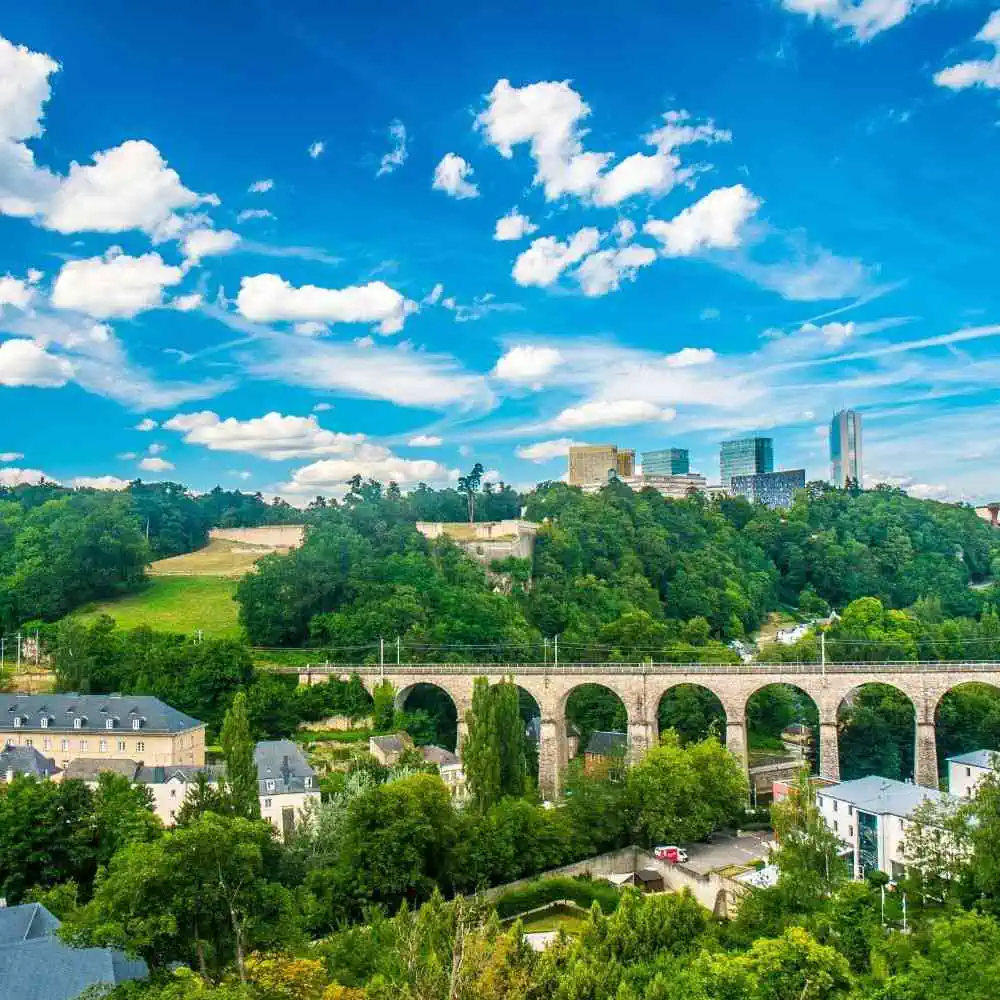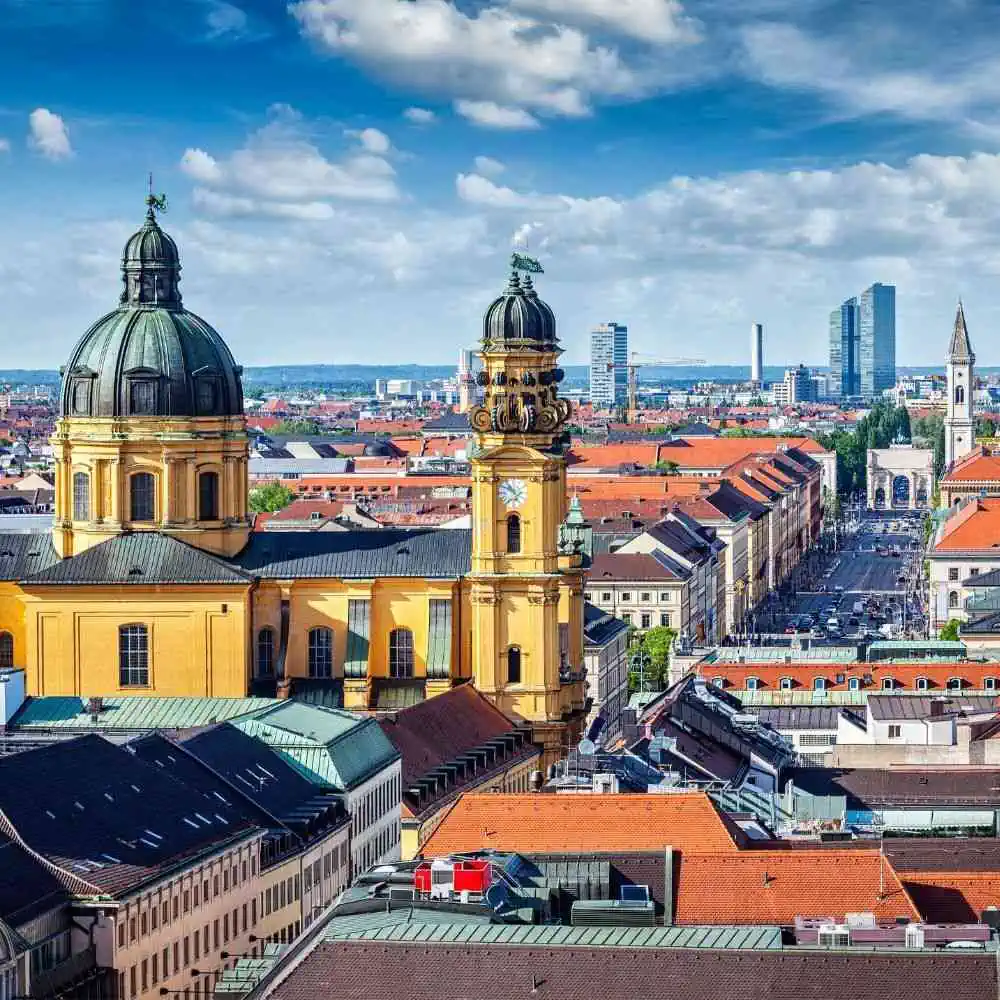You will depart from Munchen Hbf, located right in the city center of Munich, and enjoy the beautiful scenery of the journey while you arrive in Luxembourg, also located in the heart of Luxembourg.
Trains from Munich to Luxembourgfrom € 55.00
Trains from Munich to Luxembourg
Travelling by train: Munich - Luxembourg
Traveling from Munich to Luxembourg by train is a convenient and scenic way to experience the beauty of Europe. With just a few hours of travel time, you can take in the many sights along the way.
The journey from Munich to Luxembourg by train is approximately 406 kilometers and takes around six hours. You'll pass through several important cities, such as Nuremburg, Kaiserslautern, Saarbrücken, and Trier, before reaching your destination. During the trip, you'll also pass through smaller towns and villages, each with its own unique charm and culture to explore. The main station in Munich is called München Hauptbahnhof and you'll arrive in Luxembourg at Gare Centrale. During the journey, there is plenty to see – from the Duke's Palace in Kaiserslautern to the Moselle River Valley in Trier – and plenty to explore. The most beautiful, and perhaps the most iconic, sight during the journey is the ancient Roman city of Trier, which is renowned for its well-preserved Roman sites and monuments.The journey from Munich to Luxembourg by train is an enjoyable and convenient way to travel. With the journey taking only six hours, you will have plenty of time to relax and take in the scenery along the way.
To make your journey more enjoyable, it is recommended that you book a seat in advance. This will ensure that you have the most comfortable journey possible and will also help ensure that you arrive on time. Additionally, there are several cafes and restaurants on board the train, offering travelers a variety of delicious snacks, meals, and drinks to enjoy.Traveling from Munich to Luxembourg by train is a wonderful way to experience the beauty of Europe. With just a few hours of travel time, you can see the sights and explore the culture of the many towns and cities along the way.

Journey details
How long does the train from Munich to Luxembourg take?
The journey time can vary, but on average, the train from Munich to Luxembourg takes approximately 6 to 8 hours.
What is the fastest journey from Munich to Luxembourg by train?
The fastest train journey from Munich to Luxembourg typically lasts about 6 hours.
How much does the train cost from Munich to Luxembourg?
Train ticket prices from Munich to Luxembourg can vary, but you can expect to pay approximately €60 to €150 depending on when you book and the class of service.
How much does the Munich to Luxembourg?
No, there are no direct trains from Munich to Luxembourg. One or more changes may be required depending on the selected route.
What is the distance from Munich to Luxembourg by train?
The distance from Munich to Luxembourg by train is approximately 500 km.
Which are the cities that the train stops from Munich to Luxembourg?
The train from Munich to Luxembourg may stop in several cities, including Nuremberg, Frankfurt, and Koblenz. The exact stops depend on the chosen route and service.
Munich: Places to see
Munich (München), in Germany is a fascinating destination that offers visitors a blend of city delights, lively culture, and rich historical and architectural gems to explore. From soaring cathedrals to beautiful parks to world-famous beer halls, there is something for everyone in this Bavarian city. Here is a list of seven must-visit sites while in Munich, including information on each spot’s historical and architectural significance, practical details, and insider tips.
Nymphenburg Palace: The grand Baroque palace, built for Elector Ferdinand Maria in 1664, is now a museum featuring beautiful galleries and gardens. Located in the western section of Munich, it is a great spot for a leisurely stroll. Entrance is €12.50 and it’s open until 6 pm. Take a guided tour to learn more about its history.
Hofbräuhaus: This legendary beer hall has been around since 1589, and remains one of the most iconic spots in Munich. Here, visitors can sample the city’s famous Bavarian beer while enjoying traditional Bavarian dishes. Prices are quite reasonable and its open until at least 11 pm. Come early to avoid the crowds and find a good seat.
Marienplatz and City Hall: Located in the heart of the city, Marienplatz is one of Munich’s most iconic squares. The Old City Hall (Altes Rathaus) here is a magnificent Gothic building, while the New City Hall (Neues Rathaus) boasts a unique Neo-Gothic exterior. Free to visit. Catch the famous Glockenspiel at the New City Hall at 11 am or 12 pm.
English Garden: This large public park is a haven of nature and tranquillity in Munich. Spanning an area of more than 920 acres, it’s a great spot for a relaxing walk or a picnic. It also features a beer garden. Free to visit. Take a boat ride along the lake for the perfect romantic evening.
Frauenkirche and St. Peters Church: Located on Munich’s central pedestrianised street, these two churches are important landmarks that offer visitors a glimpse of the city’s religious traditions. Frauenkirche is an impressive Gothic building, while St. Peters is a more modern structure. Free to visit. Look out for the beautiful stained glass windows inside.
BMW Museum: Learn all about the famous German carmaker at this factual and educational museum in Munich. Visitors get a comprehensive overview of the company’s history, as well as a chance to explore some of its iconic cars. Entrance is €12 and the museum is open until 8 pm. Book a guided tour to get the full experience.
Viktualienmarkt: This colorful, traditional food market is the perfect place to sample some of Munich’s local specialties. Here, visitors can find Bavarian sausages, freshly baked pretzels, cheeses, cakes, and plenty of other delicious treats. Free to visit. Stop by on a Sunday morning to experience the market in all its glory.
A trip to Munich provides a wealth of experiences for travelers, from beer halls to old churches to fascinating museums. Whether you’re looking for a cultural exploration or a romantic getaway, the city’s diverse offerings guarantee an enjoyable time.

Luxembourg: Places to see
Cheese, castles, and cobblestone streets - a visit to Luxembourg is a trip through Europe’s most delightful destinations. Whether you’re keen to explore Luxembourg’s historical sites or sample the country’s delicious local cuisine, there’s something for everyone. With its central location in the heart of western Europe, Luxembourg is the ideal destination for travelers looking for a unique, immersive experience. Here’s a list of the seven must-visit historical and architectural sites and what to eat when in Luxembourg.
Grand Ducal Palace: This is the official palace of the Grand Duke of Luxembourg and remains a key cultural hub in the city. Visiting the palace is free, and opening hours are 8am-4pm. Inside you’ll get to experience luxurious, gothic-style interiors, as well as a breathtaking view of the Alzette and Petrusse valleys.
Casemates of Luxembourg: This complex of underground tunnels was built in the 17th century and served as a fortress during the Napoleonic wars. It is located in the UNESCO-listed city centre, and the entrance fee is €6.50. Visitors will find tunnels, bunkers, and some stunning views of the city from the top of the fortress walls.
Bock Casemates: Also located in the city centre, the Bock Casemates are a network of tunnels built in the 10th century. It is said that this incredible fortress once housed up to 30,000 people, and is the most visited tourist attraction in the country. Entrance fees are €7.40, and opening hours are 8am-7pm.
Notre-Dame Cathedral: This intricate Gothic-style cathedral is also part of the UNESCO World Heritage Site. It is the most well-known and well-preserved religious building in Luxembourg, and has been standing since 1613. Entrance is free, and a guided tour can be booked in advance for a €6 fee.
Pattiserie Levallois: Visiting Luxembourg is not complete without sampling some of the country’s delicious pastries. Pattiserie Levallois is a must-visit for anyone who’s looking to taste some of the best pastries in the city. From the traditional kugelhopfs to the decadent éclairs, there’s something for everyone here.
Alzette Valley: The Alzette Valley is a nature reserve located in the south of Luxembourg and is the perfect spot for a day trip. Here, visitors can take a leisurely stroll along the river, or take a tour of the many castles and monuments that line the valley. An entrance fee of €4 per person is required to access the park.
Luxembourg City History Museum: Located in the heart of the city, the museum provides an in-depth insight into the history and culture of Luxembourg. The museum has a range of interactive displays and exhibits, as well as a cafe. There is an entrance fee of €7 for adults, and it is open from 10am-6pm.
A trip to Luxembourg is guaranteed to be a memorable one. From the historical and architectural sites to the delicious local cuisine, there’s something for everyone in this charming European city. So go explore and experience all that Luxembourg has to offer.

Munich: Main train stations
Munich, in Germany is home to the country's largest train station, München Hauptbahnhof. Connecting the city to over 150 destinations and serving as many as 450,000 passengers a day, it is the busiest train station in Germany. There are also other important train stations in Munich such as München Ost, München Pasing or München Laim.
München Hauptbahnhof is situated at Bayerstrasse 10a-c, 80335 Munich. It is open 24 hours a day, 7 days a week. There are several services available, including luggage storage and a staffed information desk. The station can be reached by car and public transport such as S-Bahn, U-Bahn and buses, and is located near the city center, allowing passengers to reach popular tourist attractions easily.
- Munchen Hbf
- Munchen Ost
- Munchen-Pasing
- Munchen Hackerbrucke
Luxembourg: Main train stations
Luxembourg is a small country in Europe and its main train station is Luxembourg Central Station. This station is served by national operators and international companies. It connects Luxembourg with the main cities in the surrounding countries. Additionally, there are other important train stations in the city such as Pétange-Aubange, Esch-sur-Alzette and Differdange.
Luxembourg Central Station is located at Place de la Gare, L-1616 Luxembourg. The station is open 24-7 and there is a ticket office with detailed information about timetables and tickets. It also offers services such as toilets, a baggage storage room and free Wi-Fi access. You can contact the staff at +352 2489 2489.
- Luxembourg
Munich - Luxembourg: How to get the best deals
Book in Advance:
Just like with airfares, train ticket prices tend to rise as the departure date gets closer. Booking weeks or even months in advance can save you a significant amount.
Travel During Off-Peak Hours:
Avoid traveling during peak times such as weekday mornings and evenings. Opt for midday, late evening, or mid-week rides when there's less demand.
Consider Slower Trains or non direct routes:
Express or high-speed trains might save time, but they're often pricier. Opting for regional or slower services can reduce your fare.
Look for Special Deals and Promotions:
Train operators occasionally have promotions or special deals, especially during off-peak seasons. It's worth signing up for newsletters. Additionally, there are sometimes group or return ticket discounts, so consider these options if they fit your travel plans.
All you need to know about
Need our help?
- Contact Us
Guaranteed secure payment
Certificates


